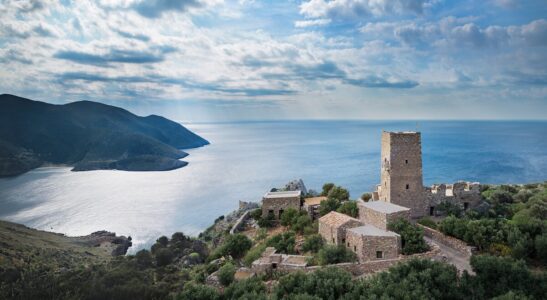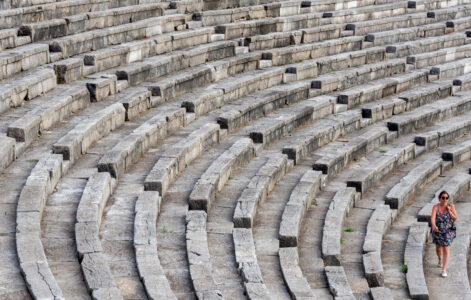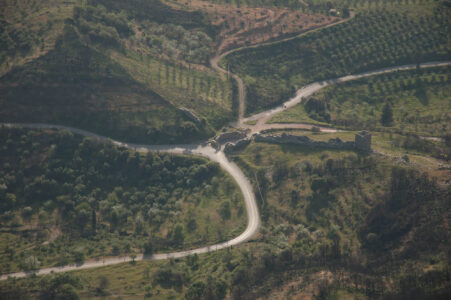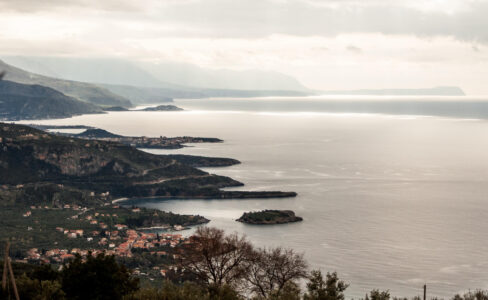10 Timeless Monuments of Ancient Greece
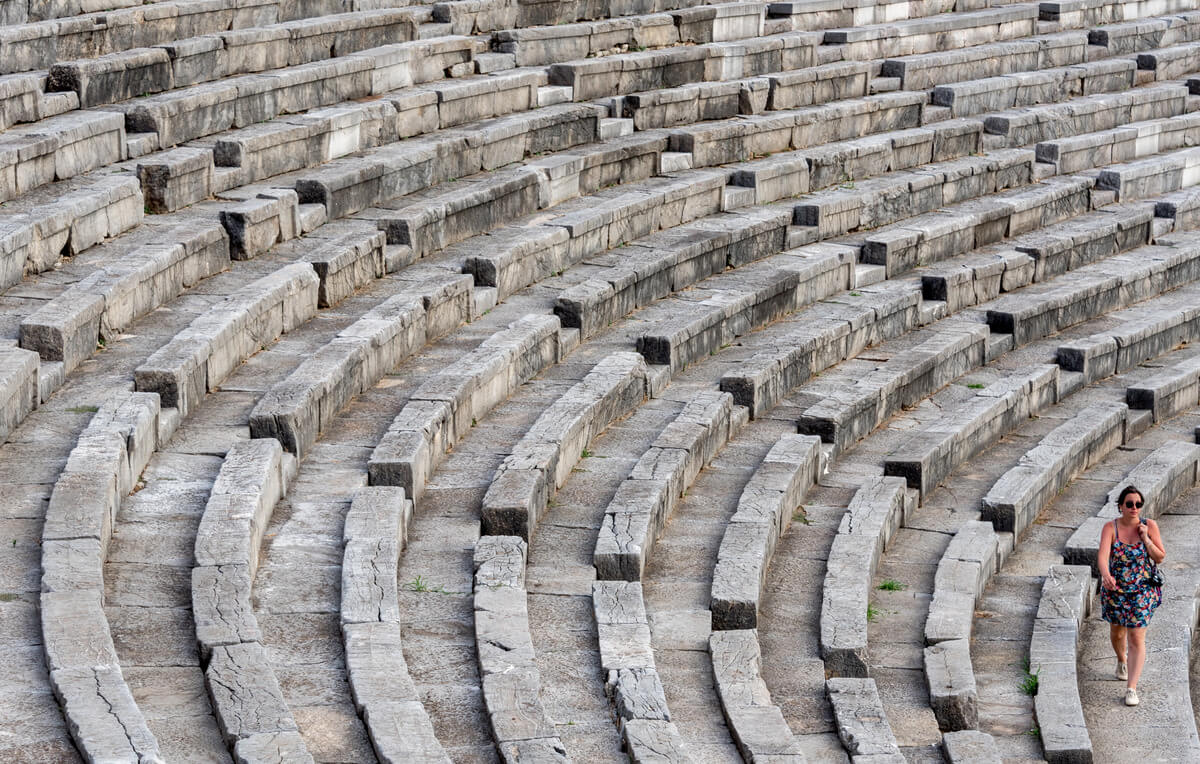
The south of Greece is a treasure trove of historical splendor, where the echoes of bygone eras resonate amidst the ruins and fortresses that pepper its landscape. From Mycenae's enigmatic walls to Mystras' medieval ruins, from the Temple of Apollo Epicurius—the paragon of ancient Greek temple architecture—to the formidable forts of Messinia, each site narrates a chapter of a rich and multifaceted history. Delphi's spiritual magnificence and Ancient Corinth’s vivid historical passages offer not just a walk through ancient civilizations but also an inspiring testament to humanity's enduring legacy. This guide journeys through these monumental locations, offering insights into their past grandeur and the timeless stories they safeguard within the heart of Greece.
Table of Contents
Step back in time and walk the cobblestoned paths of history as you explore the ancient and medieval sites of southern Greece. Each historic site, from the imposing forts to the sanctuaries of the gods, tells a tale of glory, artistry, and human endeavor. They are not simply places but portals into the past, offering a mosaic of narratives etched into stone and memory alike, beckoning explorers and scholars to uncover the layers of history that shaped our world. Here, among the vestiges of ancient civilizations, one can truly grasp the essence of Greece’s enduring influence.
- The Acropolis
Whenever it comes into view in Athens, the grandeur of the Acropolis inevitably captivates onlookers. Its enduring presence amidst the evolving scenery of a city that has taken its name from the deity honored by its most renowned sanctuary is awe-inspiring. What stands before us today, along with the treasures housed in the proximate Acropolis Museum, is a testament to the extraordinary skill and ingenuity of the Classical era’s master builders and artisans. One cannot help but be awed by the intricate details of the Parthenon (a tribute to the goddess Athena, undoubtedly the archetype of ancient Greek temples), the noble Caryatids of the Erechtheion upholding its portico with grace, and the elaborate design of the Temple of Athena Nike. Their allure is undeniable. Given its prestige as the most celebrated acropolis in Greece and its status as a UNESCO World Heritage site since 1987, it’s no wonder this landmark continues to be an emblem of the legacy bequeathed by Greek antiquity. Closer look reveals that it’s not only an icon of cultural significance but also a masterwork of architectural brilliance and creative expression.
- Ancient Epidaurus
Struggling to decide on the must-see cultural landmarks in the Peloponnese? Let’s start with a marvel of antiquity, the Theatre of Epidaurus, remarkably well-maintained since its creation in the 4th century BC. Beyond providing entertainment, this historic venue remains active today, hosting performances during the prestigious Athens & Epidaurus Festival. Yet, there’s more than meets the eye—the theatre was originally part of a comprehensive healthcare complex honoring Asclepius, the deity of healing. Travelers journeyed from across the Hellenic world and beyond to seek the Epidaurus healing experience, a fusion of medical treatments, spiritual ceremonies, athletic contests, and dramatic spectacles. To fully appreciate this immersive treatment for both body and soul, don’t miss the opportunity to test the theatre’s renowned acoustics. Prepare to be amazed by the incredible sound quality that has captivated audiences for centuries.
- Ancient Messene
Discovered only a few decades ago, the once-hidden valley of Ancient Messene has since brought to life the accounts of the renowned traveler and writer Pausanias, who described the city during his visit in the mid-2nd century AD. The city, which experienced a renaissance of prosperity after the collapse of Spartan dominance in the 4th century BC, has left behind one of Greece’s most well-preserved archaeological treasures. Visitors today can wander through a vast cultural heritage site that includes an amphitheater that held 10,000 spectators, an expansive stadium, a formal gymnasium, and a myriad of temples and structures laid out in the orderly Hippodamian fashion. The impressive fortifications that trail up towards Mt Ithome once spanned an impressive 9 kilometers in their prime. Visitors are encouraged to explore the region with an E-bike to get a complete overview of the area
- Ancient Olympia
The awe that grips us when we reflect on the fact that, over two and a half millennia past, the forerunners of today’s athletes competed here during the ancient Olympiad, remains undiminished. Here, even now, the Olympic Torch is kindled using age-old methods before it embarks on its journey to the modern Games. Visitors can stand on the same starting line as the ancients, gaining insight into the site’s deep religious roots, marked by the presence of sacred sites for deities like Zeus and Hera. This location was once adorned with the majestic statue of Zeus, fashioned from ivory and gold, and acclaimed as one of the Ancient World’s Seven Wonders. The remnants of training facilities and other sports structures remain to be explored. Undoubtedly, Ancient Olympia stands as a monument of monumental significance in the Peloponnese landscape.
- Mycenae
Getting on a journey through the annals of European antiquity, we find ourselves at the reverential Late Bronze Age city of Mycenae (circa 1250 BC), associated with the fabled hero of the Trojan War, King Agamemnon. This ancient locality, often referred to as the City of Gold, stands as one of the most fascinating historical sites within the Peloponnese region. As you pass beneath the Lion Gate, the gaze of stone lions peers down at you, guardians of the city. The colossal size of the so-called Cyclopean Walls is a marvel — their name suggesting that only the mythical Cyclopes could have erected them. Among the notable structures of Mycenae is the impressive Tholos Tomb of Clytemnestra.
- Mystras
The Peloponnesian cultural landscape extends well past its ancient wonders. Mystras, the fortified city perched atop a hill dating back to 1249, stands as one of Greece’s most significant medieval treasures. It thrived as a pivotal Byzantine stronghold, especially during the rule of the Palaiologos dynasty from the 14th to the 15th centuries, before coming under Venetian and then Ottoman control. Its palatial ruins, ecclesiastical structures adorned with frescoes, and various edifices are arranged over three interrelated urban zones, with the present-day monastic residents being the nuns at the Convent of Pantanassa. Visitors are often captivated by the panoramic vistas of Laconia valley’s citrus and olive plantations and the rich cultural history. Additionally, for those enchanted by the natural world, Mystras is a stop along the E4 pan-European walking path, which meanders along the slopes of majestic Mt Taygetos.
- Temple of Epicurius Apollo
The Temple of Apollo Epicurius, acclaimed for its unique blend of architectural styles, stands as the first ancient Greek temple designated as a UNESCO World Heritage Site in 1986. This architectural marvel is singular in its combination of the Doric, Ionic, and Corinthian orders within a single structure. Ictinus, one of the masterminds behind the Parthenon on the Acropolis of Athens, is credited with its design. The site is regarded as one of the most significant in the Peloponnese, with the temple held in high regard by the famed historian Pausanias during his travels. Visitors are encouraged to visit the nearby Neda Gorge to complete a fascinating experience.
- The Forts of Messinia
Castles and Forts abound in Greece, much to the surprise of many. Credit goes to the Franks and Venetians for the myriad of castles scattered across the Greek mainland and isles, but it’s the Peloponnese region that truly showcases Greece’s grandeur in medieval fortifications. Within a brief drive across Western Messinia, you can journey through some of the most majestic castles dating back to the 13th through the 17th centuries. At Koroni, the strategic importance of its castle town is evident, once serving as a bastion for the easterly merchant routes. In contrast, Methoni’s fortress stands out as one of Greece’s most spectacular, with its sea-encircled Bourtzi tower. Then there’s Pylos, where the well-maintained Neokastro (New Castle) of the Ottoman period holds historical fame for its part in the 1827 Battle of Navarino, fought entirely with sailships. These castle towns, not excluding their nearby tavernas and inviting swimming locales, lead to the beach that must not be overlooked – Voidokilia, near Pylos. This horseshoe-shaped beach under the watchful eye of the Frankish Paleokastro (Old Castle), promises a sight to behold.
- Delphi
The mystical symbiosis between humans and their deities revealed in Ancient Delphi still captivates today. The majesty and tranquility of this sacred locale defy the constraints of photography and the written word; it’s a place where emotions transcend mere description. As legend has it, Zeus’s eagles, while in search of the earth’s navel, converged upon this very spot—an area that also witnessed Apollo establishing his shrine upon vanquishing the serpent Python. Declared a UNESCO World Heritage Monument in 1972, the Delphic landscape in Central Greece, along with its monumental archaeological site—which ranks among the foremost significant ancient sites of Greece, is humanity’s treasure. In Delphi, as you stand amidst the legacy of the ancients, it’s almost certain you’ll feel a resounding connection to the extraordinary capacity of human achievement and the profound force of the divine.
- Ancient Corinth
A mere stone’s throw from the dividing line of southern Greece, the Corinth Canal, lies the ancient city of Corinth. Visitors can wander amidst the ruins of the Temple of Apollo and later historical remnants like the Roman Forum, and imagine the bustling life of a city that housed 90,000 inhabitants around 400 BC. Centuries later, it became the city where Apostle Paul chose to live and deliver his sermons. Close by, the towering fortress of Acrocorinth (the acropolis of ancient Corinth) stands guard. This fortress is a tapestry of history, with layers representing the Mycenaean to Medieval periods, highlighting its importance as a critical bastion defending the Peloponnese and the isthmus against invaders. At its elevated position, visitors are treated to breathtaking vistas of the surrounding sea and land, recognizing the fortress’s strategic significance that was maintained for millennia, particularly with the extant walls erected during the Venetian period.

